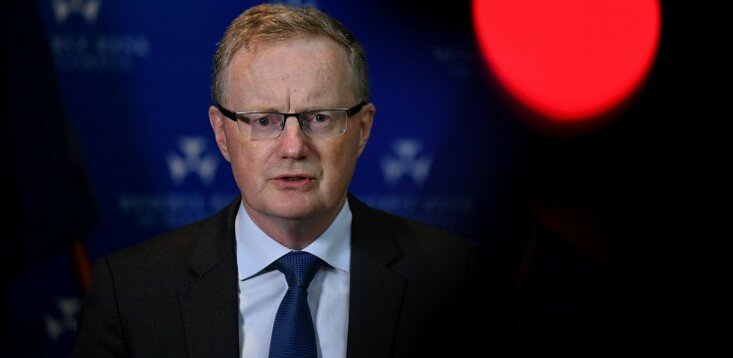Global inflation likely to stay around, RBA says, as wages and trade credit unfold

Reserve Bank Governor Philip Lowe. Source: You/Joel Caret.
Global inflation is “high and likely to remain so for some time”, but the outlook for domestic business investment and wage growth remains somewhat positive, the Reserve Bank of Australia said on Friday.
The central bank today issued its quarterly statement on monetary policy, as major economies around the world grapple with rising costs and the prospect of a hike in interest rates.
The lingering economic and logistical effects of COVID-19, as well as the conflict in Ukraine, have shattered supply chains and raised the cost of fuel, food and commodities around the world.
Those pressures are evident in the local market, where headline inflation was 5.1% in the March quarter, and is now projected to be closer to 6% by the end of 2022.
Receive daily business news.
Latest stories, money information and expert advice. Free to sign up.
“The outlook for inflation is also materially higher than it was three months ago,” the RBA said today.
The recent uptick was instrumental in the RBA’s decision on Tuesday to raise its cash rate target from a record-low 0.1% to 0.35%.
credit expectations
While this increased cash rate target is already driving up the cost of business loan repayment, the RBA today recognized mixed sentiments from industry participants.
“The growth in non-mining business investment is expected to resume in the period ahead, after halting in the second half of 2021,” the RBA said.
“Growth in trade credit remains strong.”
“Some banks expect lending growth to remain strong in the coming year, on account of generally positive economic conditions and high levels of M&A activity over the past 12 months,” the central bank said.
Industry experts say borrowers can expect credit to remain available in the coming months even as banks re-evaluate their lending norms.
However, “others have noted that economic uncertainty, rising input costs and expectations of rising interest rates may contribute to some of the slowdown.”
The RBA noted that small business lending remained relatively flat in the March quarter.
pay increase in focus
Wage hikes, another major focus for the central bank, came under scrutiny in Friday’s report.
“Despite the low unemployment rate, wage growth is not keeping pace with inflation, so real wages have declined – in some cases notably,” the RBA said.
The RBA says wage hikes to date are only approaching their sluggish pre-pandemic levels.
Yet some positive signs exist for workers in high-demand areas.
“Labor cost pressures are building, however, with a growing share of contact contacts now reporting that they are paying large wage increases or that they expect materially higher wage growth in the coming year.
“Occupational surveys are also consistent with increases in labor costs, as is growth in job turnover.”
Returning to the fact that inflation is easily outpaced by wage increases, the RBA suggested that workers may demand wage increases to maintain their cost of living.
“However, it is difficult to predict how successful these efforts will be and how quickly if they do occur,” the report said.
“These uncertainties are prominent in Australia, where until recently there has been little experience of how the labor market and inflation may behave when unemployment is as low as it is currently.”
a global perspective
As Australia leans deeper into a high-inflation environment, global neighbors are facing similar pressures.
Prime Minister Scott Morrison made headlines in New Zealand this week when he compared Australia’s key inflation rate of 5.1% to the 6.9% annual increase in front of the country’s trans-Tasman neighbors.
“Look at the gap in New Zealand, look at Canada,” Morrison told reporters after the RBA’s announcement on Tuesday. “There are few places where people would rather be here in Australia,” he said.
The Reserve Bank of New Zealand raised its cash rate by 50 basis points to 1.5% in April, its biggest single increase since 2000.
“There is an elevated level of uncertainty created by the persistent effects of COVID-19,” the central bank said, along with the impact of the conflict in Ukraine and its impact on global commodity markets.
Other regional players are facing intense inflationary pressures.
Australia’s biggest trading partner China saw its consumer price index rise 1.5% in March. While the cost of purchasing goods and services has not risen elsewhere, the pricing pressure appeared more pronounced in the country’s producer price index, which climbed 8.3%.
The volatile price of food, including cooking oil, peppers and eggs, pushed Indonesia’s inflation rate up to 2.64% in March, up from 2.06% a month earlier.
Even in Japan’s historically deflationary economy, inflation rose to 1.2% in March. However, this increase was not driven by long-expected wage increases, but rather the cost of food and energy in a nation largely dependent on imports.
While far below inflation rates in other countries, rising costs are already marginalizing Japanese citizens. A draw-down of household savings to meet rising prices – similar to the buffer earned by many Australians – has been smaller than expected.
The United States’ key inflation rate of 8.5%, and the Federal Reserve’s decision Thursday to raise its cash rate target by 50 basis points to .75%-1%, have battered investor confidence.
The stock market valuation of tech giants like Google, Amazon and Apple fell in response. Tech stocks disappeared by more than a trillion dollars in value, as traders gave up on growth stocks viewed as riskier prospects in a highly inflationary environment.
Canada – Morrison’s second target for comparison – recorded annual inflation of 6.2% in March.
In the UK, the cost of energy and food has driven inflation up to 6.2%. That spike prompted the Bank of England to hike rates to 1% on Thursday from a 13-year high of 0.75%.
In a grim note, the institute forecast inflation to reach 10% in the last quarter of 2022, with macroeconomic havoc on the cards: unemployment could rise to 5.5% in three years’ time due to a “sharp slowdown in demand growth”. Is. Said it.
Inflation is rampant in other major European economies, with France, Italy and Germany recording March rates of 4.5%, 6.5% and 7.3%, respectively.
All told, these economic ups and downs can impact Australia’s economy as well.
“Overall, growth for Australia’s major trading partners is projected to be around 4 per cent in 2022 and 2023, below its pre-pandemic decade average,” the RBA said.




